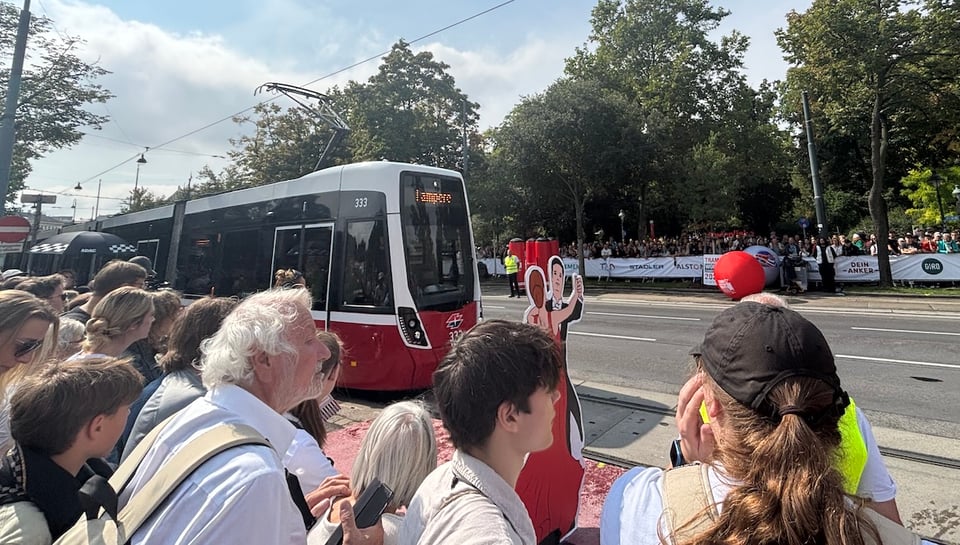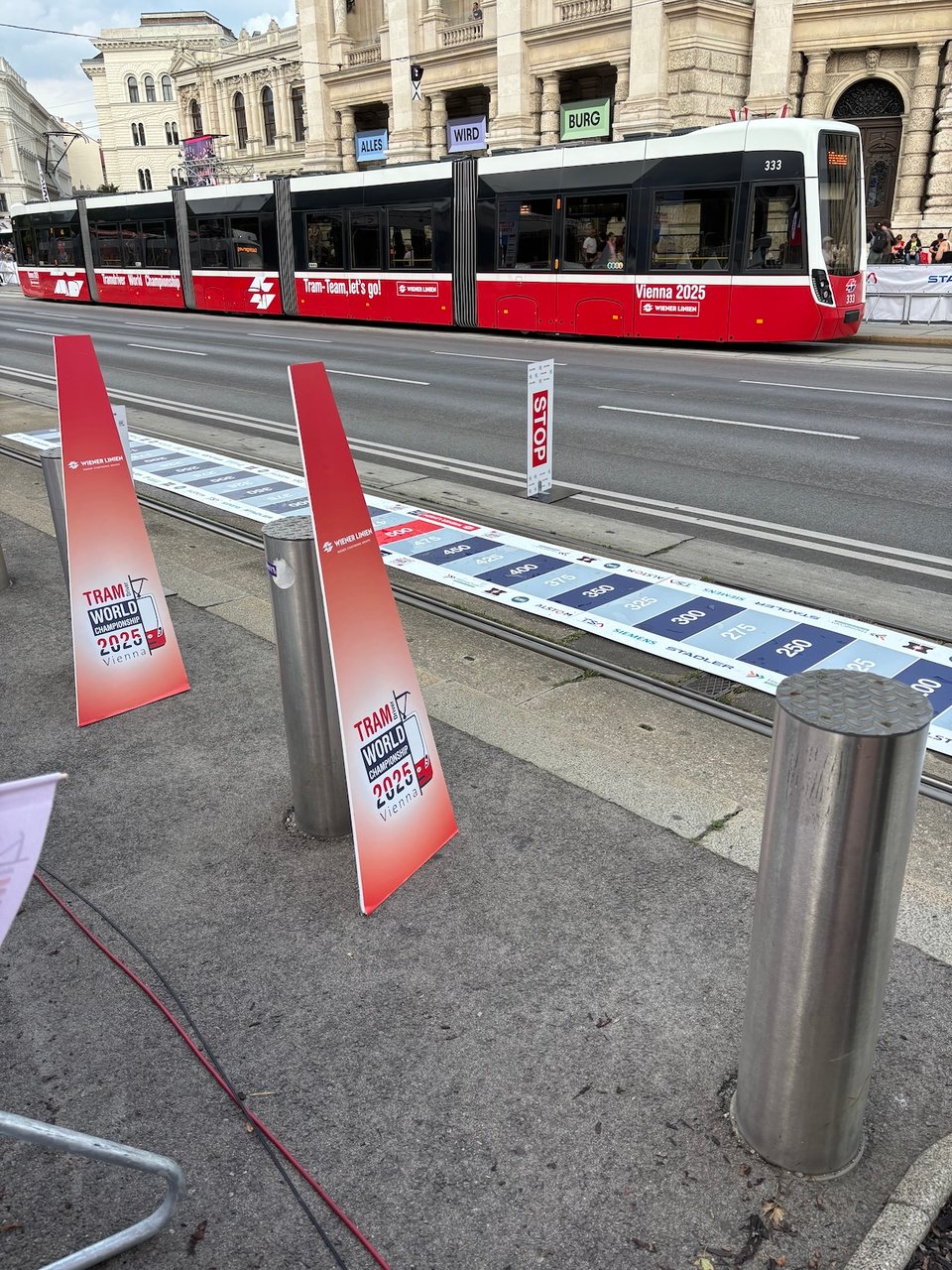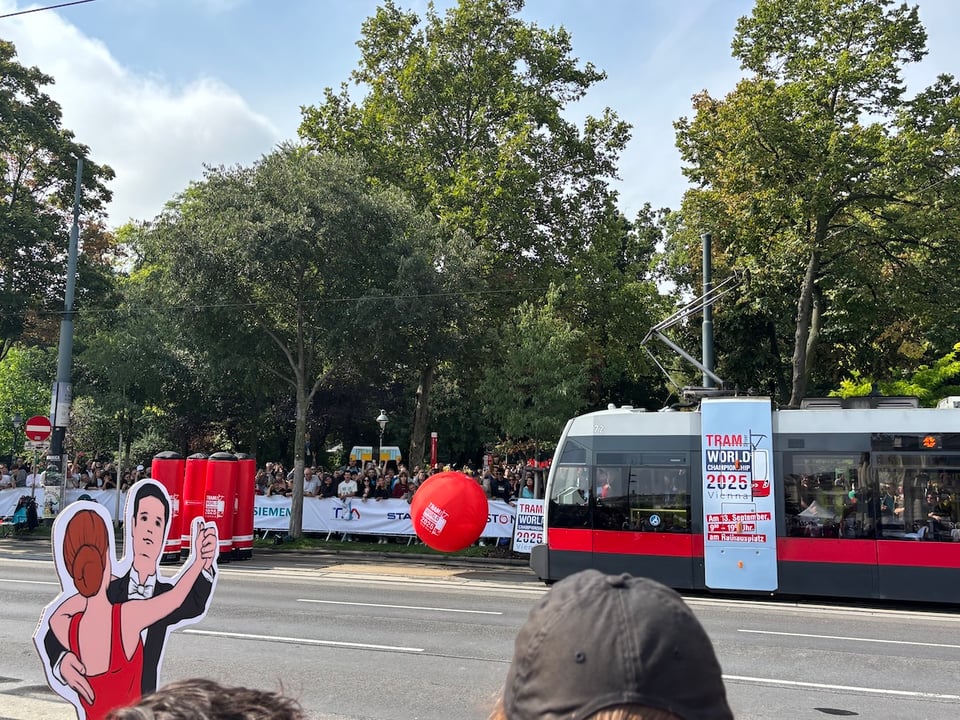The World Tramdriver Championships
Heya,
Whoops, it’s been a while! But how better to start sending these again than to tell you all about the WORLD TRAMDRIVER CHAMPIONSHIPS in Vienna, which my friend Jude and I went to last weekend. If you’re not interested in the WORLD TRAMDRIVER CHAMPIONSHIPS then I’ll catch you next time, today is a very tram-forward edition I’m afraid.
But… what? How can you be a champion tram driver? Aren’t trams, famously, on tracks? Is it… a race? What counts as good? How is it judged? These are all questions I shared before attending the WORLD TRAMDRIVING CHAMPIONSHIPS, and which I am now fully qualified to answer.
The setup for the WORLD TRAMDRIVER CHAMPIONSHIPS is as follows:
Two parallel tram tracks
One tram on each
Eight different driving tasks set up along those tracks
25 teams, representing different cities from around the world (but mostly Europe)
Two drivers for each team — usually one man and one woman
All the photos I took are terrible so I won’t be including many but here’s one to give the general sense of sun, tramlines, medium crowds all along on both sides of the road:

Each team performs the set of eight driving tasks twice — once with one driver leading and the other supporting, then again later in the day with those roles switched around. It takes four or five minutes to do the full circuit, so with 50 drivers and a break in the middle, the whole thing runs six hours or so. Drivers can get up to 500 points for each task, and there’s another 500 available based on how quickly they get through the whole thing.
The first task is the NOT SPILLING task. Drive a tram (from a secondary driving spot at the back!) that has a full bowl of water strapped to it. Stop three times in marked spots, spilling as little water as possible; the bowl is on a scale, and the less you spill, the more points you get.

Then, run inside the tram to the front, and head off in the other direction. This is the DRIVE A PARTICULAR SPEED task. You’re trying to cover a certain distance at an average of exactly 25 kilometres an hour — but your speedometer has been covered up, so you have to judge it by eye and feel.
Okay, now that you’re going along at approximately 25km/hr it’s time for the STOPPING TASK (version 1). You need to stop with the front of the tram at a particular spot, but you’re only allowed to engage the brake once, no jiggling around. This is the marker on the ground showing the target location, and the scoring chart laid out on the ground — taken after the championships ended and I was able to get closer:

The big red shape in the front is a kind-of set square that the adjudicators use to check exactly where the front of the tram lines up with the scoring track. I love the detail of all this, that someone designed it and figured out how tall it had to be and sent it off to the printer.
Next comes the BOWLING task. This is the one that turns up in all the publicity for the event, because it looks very funny. Five huge inflatable pins, and a big big inflatable ball that the tram driver has to run into to knock it along the tracks. 100 points per pin you knock down (as long as you don’t drive too far and touch any of them with the actual tram).

After that it’s time for the REVERSING task, where the support driver gets out and uses a whistle to signal for the main driver to reverse and stop — again, aiming for a particular spot. The driver isn’t allowed to use their mirrors, or turn around; it’s all done by whistle.
This one was really interesting! The standard whistle signal seemed to be “regular short whistles for keep going back, longer louder whistle for stop now”, but a few teams did it differently. Kyiv, I think, just had a general “okay can you hear me” whistle at the start, then a single warning “you’re getting close-ish” whistle and then a sharp “okay STOP NOW” whistle, which worked great.
Whenever it was time for this task, the commentator would hush everyone so that the driver could hear the whistle, and the whole crowd would comply, sudden quiet over us all. There were a few recorded announcements that he switched between to mark it, all in English. A loud “Shhhh! Quiet!!”, and a couple of other normal ones — and one that went “We will now observe a minute of silence” which was obviously a little bit weird.
After the reversing, the driver would get out of the tram and run run run to the other tram, which would be waiting for them a little bit further down on the second set of tracks. These bits where the drivers would run around — down the length of the tram, inside the tram — were so charming.
Task 6, anyway, was the DRIVE PAST A THING THAT’S REALLY CLOSE TO YOU BUT DON’T HIT IT task, which is obviously a challenge to design when your drivers are driving trams, which as covered above go on tracks. The solution was: the driver would gesture to their support driver about exactly where to put “the object” — the cardboard cutout of two ballroom dancers, visible in the photo above. Then they had to drive past it and stop. The smaller the sideway gap between the object and the tram, the more points — but if you knocked into the object at all, no points for you.
Okay, getting there! This is, please remember, only three or four minutes into the circuit of eight tasks, so it really is a very intense competition. The second-to-last task is the STOPPING task (verion 2). The difference is that you’re not trying to stop the nose of the tram anywhere, but rather judge it so that a red line inside the tram between your second set of doors lines up exactly with a particular point on the ground outside.
This one was great. Reading about it in advance I didn’t think much of it, but it was so dramatic, the tram rolling to a stop, a camera placed to capture the opening of the doors to reveal the arrow inside and where it was pointing. And the target “stop” location was on wheels so the adjudicators would move it around, which was really neat; that meant the drivers had to figure it out every time, not just them memorise what lamp post to start braking at.
And finally, of course, it was time for that classic pursuit: the TRAM CURLING task. A little trolley was placed on the tracks right in front of the tram, and the driver had to go along a little bit to get it going and knock it towards a distant scoring area. The trolley would roll along smoothly, slowly slowly slowly, dramatic, an oooooh from the crowd if it neared the 500 points marker, an ohhhhhhh if it then rolled past. The tram driver, meanwhile, would have leapt from the tram long before the trolley stopped moving, and rushed to press the end button, which blared out with a huge honk, stopping the timer from running down. Then they’d walk over to the still-rolling trolley, and watch while it came to a stop.
Overall, this was such a nice day, and so much work and thought and care had gone into it. The first-round drivers were allocated a random order, but the second-round drivers started from the last-placed team to the first, to keep the tension high, and it absolutely worked, we didn’t know who’d won right until the very very end.
Here’s some other highlights from the day:
On the way we weren’t quite sure which direction to go in, but once we got close we spotted someone who made us think ah, surely he’s here for the trams: a mid-30s white guy wearing glasses and his own high-vis vest. So we followed him for a few minutes, and that worked, he led us to the trams
But we weren’t being as clever as we thought, because it turned out we could have followed pretty much anyone; everyone in that bit of town was on their way to the World Tramdriving Championships
There was a real mix of big friend groups, couples, families desperate for something to briefly distract their children, locals popping by for half an hour, dedicated fans wearing t-shirts from previous tram championships
Some people were there an hour before the races started to camp out good places with a view of two or three key tasks at once, but mostly people popped in and out over the day
There were big screens and cameras and a commentator, but the rules weren’t particularly clearly explained, and at the start of the day it seemed like a lot of people didn’t understand how it worked. We for sure didn’t. But everyone figured it out over a few rounds, and by the afternoon we all had that superficial sport-viewer expertise, “ohhhh no they’ve fucked that one”, “too fast, too fast”, “I dunno, I think their whistle strategy just isn’t reliable”
The guy standing next to us booed Berlin!! Seems rude!!
Vienna won, which was obviously deserved — they had two excellent runs — but it felt like a bit of an anticlimax at the time because, well, the whole thing happened in Vienna. Of course the Viennese drivers won: they use these trams every day, and all the other teams had one day of practice to become familiar with them. But I’ve since looked up the list of previous hosts and winners, and it’s actually really unusual for the host city to win. It happened once before, in 2019, with Budapest, but Budapest is also the ONLY three-time championship winner so it’s not like they only managed it because of the home-town advantage, they are also just really good at driving trams. So, congratulations Vienna, I’m sorry I felt a bit eye-rolly at your victory!
As someone who used to direct festivals I very much enjoyed seeing tram-championship examples of The Staff Members Who Are At All Festivals: the woman in an off-stage area on a phonecall looking stressed, the volunteer coordinator trying to find the right-sized t-shirts for the second shift of volunteers, the Guy Who Has Been Sent To The Supermarket For As Many Bottles Of Water As He Can Carry Back etc
They put each driver’s city up on the front display of the trams while they were driving — you know, the screen that normally shows the destination — which I thought was very cute
The merch tent had a totally different selection of merch to the online shop, no idea why, but anyway now I own a World Tramdriving Championships tote bag which I look forward to showing off at the Tramdriving Championships in Warsaw 2026 or Melbourne 2027
NOT ABOUT TRAMS
Okay, just quickly, here are a few things I’ve been enjoying lately:
In games, I really liked the little puzzle-platformer Öoo, where you play a little caterpillar who gets eaten by a bird and has to find its way back outside. It’s by Nama Takahashi who also made the excellent Elechead
In books, like a lot of vaguely booksy women I’ve been reading Helen Garner’s diaries, which are of course incredible. The bits I’m most enjoying are the bits that kind-of appeal to my Australian-ness: the gossip of “oooh which Melbourne writer is this about”, the bits where Garner visits Adelaide and I get to think ah my little city!, the very specific details about the bush and the light and the ways different cities feel different, just some of the turns of phrase and types of people. It makes me think I love this book but I don’t know how it would land for people from elsewhere. Except obviously it’s landing just fine for them! And maybe they’re having the same sort of thoughts about different traits they share with Garner: I love this but I don’t know if you’d get as much out of it if you didn’t have a kid / have never been divorced / have never had a long-running affair with a married man / haven’t had strong and confusing religious feelings etc etc. Thinking as well about a conversation between friends who loved Ferdia Lennon’s Glorious Exploits, one of them going “I’m not sure it’d work as well if you didn’t know Irish politics and social dynamics”, another going “I’m not sure it’d work as well if you hadn’t studied Classics”. Books with the sort of specificity where everyone finds something different to point to and go “well this is obviously the heart of it, the book is great but I don’t know if people who aren’t like me in this respect would like it so much”
And in listening to stuff, I’ve been really liking Eight Days of Diana Wynne Jones, a podcast by the writers Emily Tesh and Rebecca Fraimow. They go through each of Jones’s novels individually, talking about each one for an hour or occasionally two. They’re currently through the 70s and 80s, with the 90s and 00s to come. When I was a kid Diana Wynne Jones was one of my very very favourite writers, and she was also my introduction to the idea that a writer could have very visible preoccupations and even weird tendencies that were arguably flaws, and that that could be part of their charm and intensity and drive. The omnipresence of bad mothers in Jones, and her Uhhhhh Let’s Wrap This All Up Real Fast endings, the way those didn’t make the books even a little bit less distinctive or compelling or memorable. I think she is still one of the three or four writers where I would be most excited if I suddenly found out they had a well-regarded book I’d somehow managed to miss, and got to read now for the first time.
Okay, that’s all for now, see you in less than six months next time!
Best,
Holly